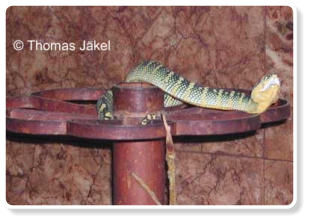




Breeding
Breeding of Wagler's Vipers in captivity is possible and not too difficult once the animals are healthy and stress (induced by cagemates or otherwise) is avoided.
Health Problems
Wagler's viper can be a problematic species in captivity. This is mainly true for wild-caught adult animals that have suffered stress and dehydration during storage and transport. Any new animal arriving in a collection should be put in quarantine for at least 2 months or longer, and kept under optimum conditions as outlined.
Natural History
Tropidolaemus wagleri is a common viper of lowland tropical rainforests in many parts of Southeast Asia. It lives on low trees and bushes and is active at night, when it waits in ambush for prey to pass by. It is highly variable in coloration and shows one of the most extreme forms of sexual dimorphism among snakes, with females growing much bigger (around 70-80 cm to more than 1 m) than males and, in most cases, showing a different color pattern during adulthood.General Husbandry
There are various attributes and statements that have been used to decribe Wagler's viper in captivity: docile snake, lethargic, beautiful but difficult to keep, problems with lung infection, constipation etc. All of these potential problems may arise, or not, depending on how one generally approaches husbandry of this snake. This chapter explores important aspects of husbandry that are necessary to consider once you want to succeed in breeding.
© 2004-2022 Thomas Jäkel












Venom
I added a new chapter on the venom of Tropidolaemus wagleri, which is based on new findings of its composition and toxicity. People requested this for a long time, but I was reluctant to write about it, since little was known beyond what was reported about the ‘Waglerin’ toxins. The new study provides some interesting read, and I tried to extract the most inportant information. I hope that this is of broader interest, not just for biochemists and toxinologists.
Image Map
A map of location-specific images of Wagler’s vipers taken from different areas in Southeast Asia. Many of the images are my own, but people enthusiastic about this snake also contributed their shots taken during travel.


© 2004-2021 Thomas Jäkel

General Husbandry
There are various attributes and statements that have been used to decribe Wagler's viper in captivity: docile snake, lethargic, beautiful but difficult to keep, problems with lung infection, constipation etc. All of these potential problems may arise, or not, depending on how one generally approaches husbandry of this snake. This chapter explores important aspects of husbandry that are necessary to consider once you want to succeed in breeding.
Wagler’s Viper Site
Breeding
Breeding of Wagler's Vipers in captivity is possible and not too difficult once the animals are healthy and stress (induced by cagemates or otherwise) is avoided.
Health Problems
Wagler's viper can be a problematic species in captivity. This is mainly true for wild-caught adult animals that have suffered stress and dehydration during storage and transport. Any new animal arriving in a collection should be put in quarantine for at least 2 months or longer, and kept under optimum conditions as outlined.
Natural History
Tropidolaemus wagleri is a common viper of lowland tropical rainforests in many parts of Southeast Asia. It lives on low trees and bushes and is active at night, when it waits in ambush for prey to pass by. It is highly variable in coloration and shows one of the most extreme forms of sexual dimorphism among snakes, with females growing much bigger (around 70-80 cm to more than 1 m) than males and, in most cases, showing a different color pattern during adulthood.Image Map
A map of location-specific images of Wagler’s vipers taken from different areas in Southeast Asia. Many of the images are my own, but people enthusiastic about this snake also contributed their shots taken during travel. NEW Nov. 2020: Images from Sulawesi



- Home
- Wagler's Viper Site (WVS)
- General Husbandry - WVS
- Breeding - WVS
- Health Problems - WVS
- Taxonomy and Phylogenetics - WVS
- Biology - WVS
- Geographic Variability - WVS
- How Females Change - WVS
- Venom - WVS
- Image Map - WVS
- Special: T. laticinctus - WVS
- Special: North Sumatra - WVS
- Special: Video on Mating - WVS
- Special: North Sulawesi - VVS
- Biological Rodent Control - BRC
- Rodent Management Laos - BRC
- Gallery
- Contact












